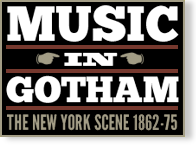Philharmonic Society of New York Concert: 5th
Event Information
Venue(s):
Academy of Music
Conductor(s):
Carl Bergmann
Event Type:
Orchestral
Record Information
Status:
Published
Last Updated:
2 May 2025
Performance Date(s) and Time(s)
14 Mar 1874, 8:00 PMProgram Details
Performers and/or Works Performed
Citations
“The fifth Philharmonic concert of the present season was given at the Academy of Music last evening, when the programme rehearsed on the afternoon of the previous day was recited with due familiarity. The entertainment was interesting enough as an ordinary concert, but it certainly lacked the distinctive features one has a right to expect in a performance gotten up by the most prominent musical organization in the country. The solos yesterday, viewed in this light, were especially unsatisfactory, for Miss Antonia Henne, although endowed with a fine voice, is deficient in the maestria of delivery exacted by such compositions as ‘Che Farò.’ Miss Henne lacks, too, the sentiment required to make works like ‘O frage nicht’ and ‘Nach hall,’ by Rubinstein, as expressive as they are intended to be. The pianist of the occasion was Mr. Emile Guyon, who plays correctly, but whose touch has failed to bring, even from a splendid Steinway, the tone many mediocre artists would have succeeded in eliciting from it. Mr. Guyon, besides, has little or no fancy, and something more than a colorless reading of the romance and rondo from Chopin’s E minor concerto is requisite to bestow upon poetical writing of this kind its charm and eloquence. The achievements of the orchestra pleased us most. Mozart’s ‘Jupiter’ symphony was recited with spirit and precision. Raff’s fifth symphony—‘Lenore’ erst and so often done by Mr. Thomas’ band—proved very effective, the andante deriving particular beauty from the volume of sound Mr. Bergmann always draws from his forces, while the march and the finale were rather inferior to the movements as interpreted by Mr. Thomas’ orchestra, whose performances for crispness and nuances are simply unapproachable.”
“The fifth concert season of the Philharmonic Society took place on Saturday evening at the Academy of Music. The first orchestral work on the bill was the ‘Jupiter’ symphony of Mozart, No. 4, in C major, opus 38, one of the grandest works in the symphonic répertoire. The performance of this work was characterized by more brio, finish and care than has been generally found at those concerts of late years. The passages for the wind instruments—which are by no means easy, and which at times tax the powers of the performers to the utmost extent—were admirably given, and the strings showed more perceptible color than usual. The other orchestral work in the programme was Raff’s ‘Lenore’ symphony, which was brought out some time ago by Mr. Theodore Thomas with great réclame. The soloists were Miss Antonio Henne, contralto, and M. Emile Guyon, pianist. The former gave an interesting rendering of the well-known scena from Gluck’s ‘Orpheus,’ ‘Che faro senza Euridice,’ but failed utterly to interpret the fanciful songs of Rubinstein which she selected for the occasion. M. Guyon played the romance and rondo from Chopin’s concerto in E minor. It is hardly in consonance with the true Philharmonic spirit to give only extracts from such a work. One would naturally expect at such a concert to hear it in its entirety. M. Guyon has a neat, graceful style; not of much breadth and lacking in warmth and spirit. A few false notes here and there betrayed the presence of nervousness; but the general effect of his performance was calculated to inspire a feeling of desire to hear him again when less affected by nervousness.”
“At the fifth concert of the New York Philharmonic Saturday evening, March 14, two symphonies were played: Mozart’s in C major, No. 4, known as the ‘Jupiter Symphony,’ and Raff’s Symphony No. 5, ‘Lenore.’ Both of these works are already familiar to us through the interpretation of Mr. Thomas. The society, which of late has been singularly unfortunate in the choice of its solo performers fared on this occasion even worse than usual; Miss Antonia Hermer [Henne], who has an agreeable voice (but no method) sang the ‘Che faro’ from Orpheus and two songs by Rubinstein (O Frage Nicht, and Nachhall,) and Mr. Emile Guyon, who has nothing whatever to recommend him, played at a Romance and Rondo from Chopin’s Piano Forte concerto in E minor, Op. 11.”

